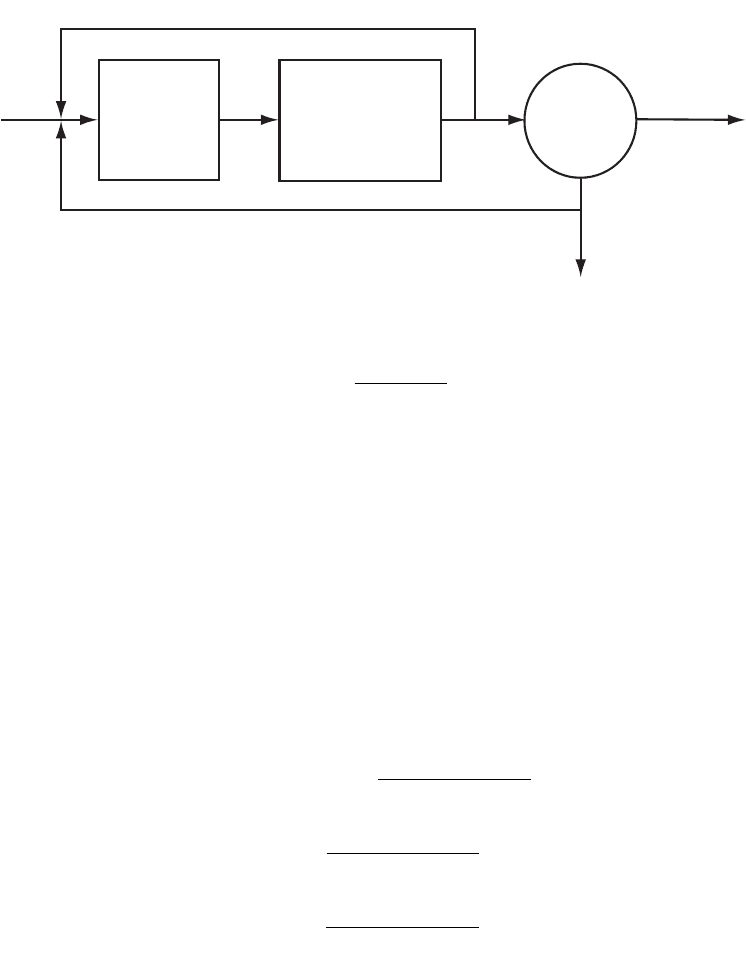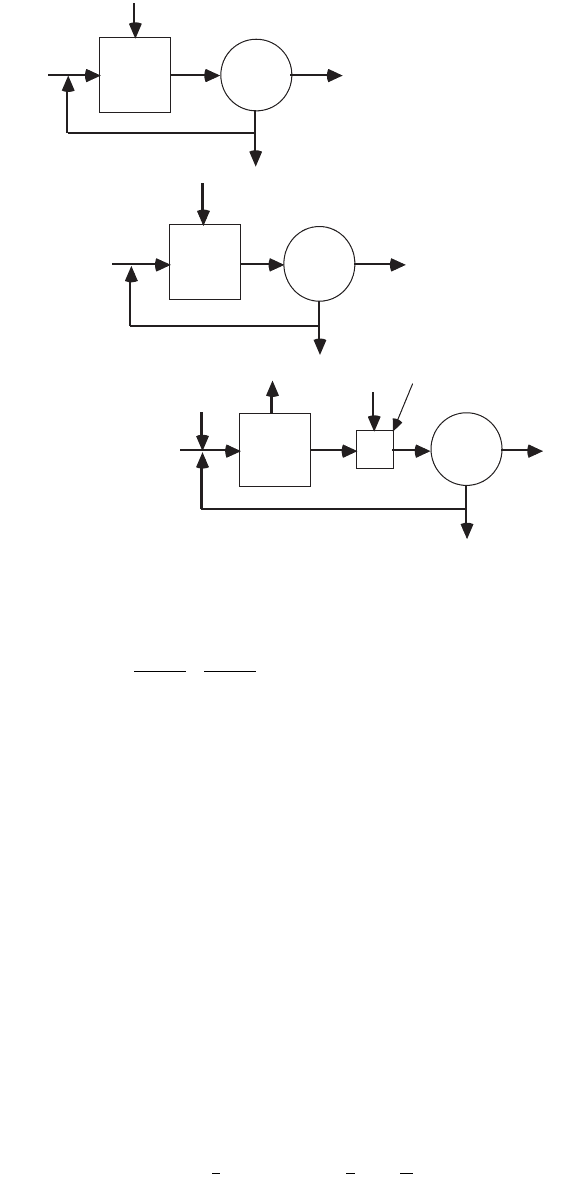Wai-Fah Chen.The Civil Engineering Handbook
Подождите немного. Документ загружается.


11-32 The Civil Engineering Handbook, Second Edition
The affinity constant for the DO correction, given here as 1.3 mg/L, may be as high as 2 mg/L in some
systems. Scheible and Heidman (1993) recommend a value of 1 mg/L.
Ammonia Inhibition
Un-ionized ammonia, i.e., NH
3
, is inhibitory to the Nitroso- and the Nitro- genera. The inhibition
threshold concentrations of un-ionized ammonia for the Nitroso- group is about 10 to 150 mg NH
3
/L;
for the Nitro- group, it is about 0.1 to 1 mg NH
3
/L. Inhibition of the Nitro- group results in the
accumulation of nitrite.
The usual way to handle these effects is to adopt the Haldane kinetic model for the specific growth rate
(Haldane, 1930):
(11.72)
where K
i
= the Haldane inhibition constant (kg NH
3
-N/m
3
).
In heterotroph-free cultures, the inhibition constant has been reported to be about 20 mg N/L at 19°C
and pH 7 (Rozich and Castens, 1986). The basis here is the total ammonia concentration, both NH
3
-N
and NH
+
4
-N.Under the given conditions, the ratio of total ammonia concentration to un-ionized ammo-
nia would be about 250:1. At a full-scale nitrification facility treating landfill leachate, the observed
inhibition constant was 36 mg/L of total ammonia nitrogen (Keenan, Steiner, and Fungaroli, 1979). The
wastewater temperature varied from 0 to 29°C, and the pH varied from 7.3 to 8.6.
Other Inhibitors
A list of other inhibitors and the approximate threshold concentration for nitrification inhibition is given
in Tables 11.4 and 11.5. The reduction in nitrification rate in some industrial wastewaters due to inhibitors
can be severe. Adams and Eckenfelder (1977) give some laboratory data for nitrification rates for pulp
and paper, refinery, and phenolic wastes that are only about 0.1% of the rates in municipal wastewater.
The reported rates are low by an order of magnitude even if ammonia inhibition is accounted for.
Carbon:Nitrogen Ratio of Feed
The usual C:N ratio in municipal wastewater is about 10 to 15. However, in many industrial wastewaters,
it may be higher or lower. In general, increasing the C:N ratio increases the heterotrophic biomass and
the “endogenous” solids in the mixed liquor.
Because the heterotrophs can metabolize at much lower oxygen concentrations than can the nitrifiers,
and at higher C:N ratios, the heterotrophs can reduce the aeration tank DO below the levels needed by
the nitrifiers. Consequently, at least in plug flow tanks, the zone of active nitrification moves toward the
outlet end of the aeration tank, and a longer aeration period may be needed.
The elevated MLSS concentrations also require larger aeration tanks, if for no other reason than the
solids’ flux on the secondary clarifier must be limited.
Design Solids’ Retention Time
The minimum solids’ retention required for nitrification ranges from about 3 days or less at 25°C to over
18 days at 12 to 15°C (Grady, Daigger, and Lim, 1999). The usual design procedure is to do the following
(Metcalf & Eddy, Inc., 2002):
•Calculate the specific growth rate [Eqs. (11.68 through 11.71)] and the decay rate [Eq. (11.41)
and Table 11.1] for the expected operating conditions and for the design load and permit condi-
tions. Note that the design load includes a peaking factor (Table 8.13). If nitrification is required
year-round, these calculations must be done for each distinct season.
•Calculate the required SRT [Eq. (11.3)].
m
m
n
nna
na na
na
i
S
KS
S
K
=
◊
++
max
2
© 2003 by CRC Press LLC

Biological Wastewater Treatment Processes 11-33
•Multiply the calculated SRT by a safety factor of about 1.5 to obtain the design SRT. Note that
when the peaking factor is accounted for, the design SRT will accommodate a loading that is at
least three times the annual average load.
True Growth Yield
The yield of nitrifiers normally includes the Nitroso- and Nitro- genera and may be approximated by
Eq. (11.67) (Scheible and Heidman, 1993). The estimated true growth yield coefficient for the nitrifiers
as a whole is 0.13 g VSS/g NH
3
-N or 0.028 g VSS/g NBOD. At least 98% of the ammonia-nitrogen is
oxidized to nitrate.
The nitrifier “decay” rate is usually assumed to be the same as that of the heterotrophs. This is
reasonable, because the so-called decay rate is really a predation/lysis effect.
Nitrifier Biomass
The nitrifier population is normally only a small portion of the MLSS. If it is assumed that the hetero-
trophs are carbon-limited and the nitrifiers are NH
3
-N-limited, then the nitrifier biomass can be estimated
from a simple nitrogen balance:
(11.73)
where f
nh
= the fraction of nitrogen in the heterotrophs (kg N/kg VSS)
ª 0.070 kg N/kg VSS (Table 11.3)
S
TKN
= the soluble TKN (not ammonia) of the final effluent (kg TKN/m
3
)
C
TKNo
= the TKN (soluble plus particulate) of the settled wastewater (kg TKN/m
3
)
Q = the settled sewage flow rate (m
3
/s or ft
3
/sec)
V = the volume of the aeration tank (m
3
or ft
3
)
X
vh
= the concentration of heterotrophs in the aeration tank (kg VSS/m
3
)
X
vn
= the concentration of nitrifiers in the aeration tank (kg VSS/m
3
)
Y
on
= the observed yield for nitrifier growth on ammonia (kg VSS/kg NH
3
-N)
Q
X
= the solids’ retention time (sec)
Organic Nitrogen Production
NPDES permits are written in terms of ammonia-nitrogen, because of its toxicity. However, a substantial
portion of the effluent TKN in nitrifying facilities is soluble organic nitrogen. As a rough guide, the ratio
of TKN to NH
3
-N in settled effluents is about 2:1 to 3:1 (Barth, Brenner, and Lewis, 1968; Beckman
et al., 1972; Clarkson, Lau, and Krichten, 1980; Lawrence and Brown, 1976; Mulbarger, 1971; Prakasam
et al., 1979; Stankewich, no date).
Two-Stage Nitrification
In the two-stage nitrification process, the nitrification step is preceded by a roughing step, either activated
sludge or trickling filter, which is designed to remove about one-half to three-quarters of the settled
sewage BOD
5
. The benefits of this scheme are that the total biomass carried in the plant and the oxygen
consumption are reduced. The costs are an additional clarifier and increased waste sludge production.
The aeration tankage requirements of two-stage nitrification are comparable to those of nonnitrifying
facilities, which suggests that most conventional plants can be readily upgraded to nitrification without
major expense. Mulbarger (1971) estimates the increase in capital cost above that of a nonnitrifying
facility to be about 10%.
The CBOD and TKN loads to the second stage are the expected effluent quality of the first stage. The
first stage effluent BOD
5
is a semi-free design choice; it determines the specific uptake rate for the first
VX
Y
QC S f
VX
vn
on X
onh
vh
X
◊
=-
()
- ◊
QQ
N consumed by nitrifiers
total N removed
N removed by heterotrophs
TKN TKN
12434
1244 344
12434
© 2003 by CRC Press LLC

11-34 The Civil Engineering Handbook, Second Edition
stage. The first stage effluent TKN is the TKN not incorporated into the first stage’s waste activated
sludge. It may be estimated by,
(11.74)
The EPA model described above can represent the nitrification kinetics of the second stage. The kinetics
of CBOD removal in the second stage is not well known. The second-stage influent CBOD is a microbial
product formed in the first stage, not residual settled sewage CBOD, and its removal kinetics may not
be well represented by the data in Tables 11.1 and 11.8.
Denitrification
A variety of proprietary denitrification processes are being marketed, including A/O™ (U.S. Patent No.
4,056,465), Bardenpho™ (U.S. Patent No. 3,964,998), and BIO-DENITRO™ (U.S. Patent No. 3,977,965).
The Joint Task Force (1992) lists other patents.
Microbiology
Many aerobic heterotrophic bacteria, especially pseudomonads, can utilize nitrate and nitrite as a terminal
electron acceptor. The half-cell reactions are as follows:
(11.75)
(11.76)
The oxygen reduction half-cell is as shown:
(11.77)
Consequently, the electronic equivalent weights of nitrite and nitrate are 1.713 and 2.857 g O
2
/g NO
3
-N,
respectively. The nitrate equivalent weight is confirmed by Wuhrmann’s (1968) data.
Growth Stoichiometry
The energy available to the denitrifiers is sharply reduced, from about 1 ATP per electron pair for oxygen-
based oxidations to about 0.4 ATP per electron pair (Sykes, 1975). This substantially reduces waste
activated sludge production.
Smarkel (1977) gives the theoretical growth stoichiometry for the anoxic growth of heterotrophic
bacteria growing on methanol and nitrate plus nutrient salts as the following:
(11.78)
This closely approximates the empirical formula given by McCarty, Beck, and St. Amant (no date):
(11.79)
The calculated true growth yields for organic matter and nitrate nitrogen are 0.172 g VSS per g COD
and 0.684 g VSS per g NO
3
-N.
Growth Kinetics
The denitrifier growth rate can be limited by the nitrate concentration or the COD concentration, and
values of the Gram model kinetic parameters have been reported for both cases. Laboratory results for
QS QC f
VX
onh
vh
X
TKN
1st stage soluble effluent TKN
TKN
settled sewage total TKN
TKN in 1st stage waste activated sludge
123123
12434
=-◊
Q
NO e H N H O
2
–– +
2
++ = +34 2
1
2
2
NO e H N H O
3
–– +
22
++ = +56 3
1
2
O e H HO
2
–+
2
++ =44 2
13 7 1 8 8 67 5 40 29 8.. ...CH OH NHO C H O N CO N H O
33572222
+= +++
108 0065 076 047 244.....CH OH NO H C H O N CO N H O
33
–+
572 2 2 2
++= + + +
© 2003 by CRC Press LLC

Biological Wastewater Treatment Processes 11-35
some of these parameters are summarized in Table 11.9. Scheible and Heidman (1993) give additional
data. While the values for the true growth yields, the microbial decay, and perhaps the affinity coefficient
for nitrate are reliable, the maximum specific growth rate and uptake rate are questionable. Large-scale
pilot studies have produced maximum specific uptake rates that range from about 0.1 to 0.4 g NO
3
-N
per g MLVSS d at 20°C (Ekama and Marais, 1984; Parker et al., 1975).
A commonly used kinetic model for the rate of denitrification is as follows (Metcalf & Eddy, Inc., 2002):
(11.80)
where f
dn
= the fraction of the active heterotrophic biomass that can denitrify (dimensionless)
K
NO
3
= the affinity constant for nitrate-limited denitrification (kg NO
3
-N/m
3
)
K
O
2
= the oxygen inhibition constant for denitrification (kg O
2
/m
3
)
K
s
= the affinity constant for substrate-limited denitrification (kg COD/m
3
)
k
d
= the decay rate of the active biomass (per s)
r
NO
3
= the volumetric nitrate-nitrogen consumption rate (kg NO
3
-N/m
3
s)
S
NO
3
= the nitrate-nitrogen concentration (kg N/m
3
)
S
O
2
= the aeration tank oxygen concentration (kg O
2
/m
3
)
S
s
= the soluble rapidly biodegradable COD concentration in the aeration tank (kg COD/m
3
)
Y
hox
= the aerobic heterotrophic true growth yield (kg VSS/kg COD)
X
va
= the active heterotrophic biomass (kg VSS/m
3
)
1.42 = the oxygen equivalent of the biomass under nonnitrifying conditions (kg O
2
/kg VSS)
2.86 = the oxygen equivalent of nitrate-nitrogen (kg O
2
/kg N)
TABLE 11.9 Typical Parameter Values for Laboratory-Scale Denitrifying
Activated Sludge Processes Using Methanol at Approximately 20°C
Parameter Symbol Units Typical
Tr ue growth yield Y
COD
Y
NO
3
kg VSS/kg COD
kg VSS/kg NO
3
-N
0.17
0.68
Decay rate k
d
Per day 0.04
Maximum specific growth rate m
max
Per day 0.3
Maximum uptake rate q
max
kg COD/kg VSS·d
kg NO
3
-N/kg VSS·d
2
0.5
Affinity constant K
s
mg BOD
5
/L
mg COD
total
/L
mg COD
biodeg
/L
mg NO
3
-N/L
150
75
10
0.08
Sources: Johnson, W.K. 1972. “Process Kinetics for Denitrification,” Journal of
the Sanitary Engineering Division, Proc. ASCE, 98(SA4): 623.
McClintock, S.A., Sherrard, J.H., Novak, J.T., and Randall, C.W. 1988. “Nitrate
Ve rsus Oxygen Respiration in the Activated Sludge Process,” Journal of the Water
Pollution Control Federation, 60(3): 342.
Moore, S.F. and Schroeder, E.D., 1970. “An Investigation of the Effects of Res-
idence Time on Anaerobic Bacterial Denitrification,” Water Research, 4(10): 685.
Moore, S.F. and Schroeder, E.D. 1971. “The Effect of Nitrate Feed Rate on
Denitrification,” Water Research, 5(7): 445.
Stensel, H.D., Loehr, R.C., and Lawrence, A.W. 1973. “Biological Kinetics of
Suspended-Growth Denitrification,” Journal of the Water Pollution Control Feder-
ation, 45(2): 249.
rfX
YqS
KS
S
KS
K
KS
fkX
dn va
hox s
ss
nd d va
NO
NO
NO NO
O
OO
3
3
33
2
22
=
-
Ê
Ë
Á
ˆ
¯
˜
+
Ê
Ë
Á
ˆ
¯
˜
+
Ê
Ë
Á
ˆ
¯
˜
+
Ê
Ë
Á
ˆ
¯
˜
+
1142
286
142
286
.
.
.
.
max
K
© 2003 by CRC Press LLC
11-36 The Civil Engineering Handbook, Second Edition
This formulation assumes that the MLVSS are partitioned as suggested by McKinney or the IWA’s
Activated Sludge Model. It includes the active biomass’ growth and decay. The formulation of the rate as
a product on Monod-like terms also assumes simultaneous kinetic limitation by the electron acceptors
and the carbon substrate. This latter assumption is unproven empirically, but it may be qualitatively correct.
Oxygen
The threshold for oxygen inhibition of denitrification is about 0.1 mg/L, and the denitrification rate is
reduced by 50% at oxygen concentrations around 0.2 to 0.3 mg/L (Focht and Chang, 1975). At 2.0 mg/L
of oxygen, the denitrification rate is reduced by 90%.
Even conventional activated sludge processes denitrify if nitrate or nitrite is present, losing as much
as 40% of the applied TKN (Johnson, 1959; Van Huyssteen, Barnard, and Hendrikz, 1990). This is
generally believed to be due to microscale anoxic zones in the mixed liquor or inside the sludge flocs.
Inhibitors
The reduction of nitrite is inhibited by nitrite. In unacclimated cultures, the nitrite reduction rate falls
by about 80% when the nitrite-nitrogen concentration exceeds about 8 mg/L (Beccari et al., 1983). This
may be due to the accumulation of free nitrous acid, because there is an unusually sharp fall in the rate
of nitrite reduction as the pH falls below 7.5.
Other reported inhibitors are as follows (Painter, 1970):
•Metal chelating agents (e.g., sodium diethyldithiocarbamate, orthophenanthroline, potassium
cyanide, and 4-methyl-1:2-dimercaptobenzene)
•Cytochrome inhibitors (e.g., 2-n-heptyl-4-hydroxyquinoline-N-oxide)
• P-chloromercuribenzoate
•Hydrazine
•Chlorate
•Copper
Tables 11.4 and 11.5 summarize some quantitative data on inhibition.
Temperature
Focht and Chang (1975) reviewed Q
10
data for a variety of nitrification processes (including mixed and
pure cultures and suspended and film systems), and Lewandowski (1982) reviewed theta values for
wastewater. The average theta for all these processes is about 1.095, and the type of reductant does not
appear to affect the value.
pH
The optimum pH for the reduction of nitrate is about 7 to 7.5 (Beccari et al., 1983; Focht and Chang,
1975; Parker et al., 1975). The rate of nitrate reduction falls sharply outside that range to about half its
maximum value at pHs of 6.0 and 8.0.
The optimum range of pH for nitrite reduction appears to be narrowly centered at 7.5. At pH 7.0, it
is only 20% of its maximum value, and at pH 8.0, it is about 70% of its maximum (Beccari et al., 1983).
Semi-Aerobic Denitrification
The simplest denitrification facility is the “semi-aerobic” process developed by Ludzack and Ettinger
(1962). This process is suitable for moderate removals of nitrate.
A schematic of the process train is shown in Fig. 11.5. In this process, mixed liquor from the effluent
end of a nitrifying aeration tank is recirculated to an anoxic tank ahead of the aeration tank, where it is
mixed with settled sewage. The anoxic tank is mixed but not aerated. The heterotrophs of the activated
sludge utilize the nitrates in the mixed liquor to oxidize the CBOD of the settled sewage, and the nitrates
are reduced to nitrogen gas.
The nitrate removal efficiency may be approximated by the following:
© 2003 by CRC Press LLC

Biological Wastewater Treatment Processes 11-37
(11.81)
where E
NO
3
= the nitrate removal efficiency (dimensionless)
Q = the settled sewage flow (m
3
/s or ft
3
/sec)
Q
m
= the mixed liquor return flow (m
3
/s or ft
3
/sec)
Q
r
= the return sludge flow (m
3
/s or ft
3
/sec)
Because of economic limitations on the amount of return flows, the practical removal efficiency is
limited to maybe 80%. If high removal efficiencies are needed, a separate stage denitrification facility
must be built.
It is assumed that the CBOD of the settled sewage is sufficient to reduce the nitrate produced in the
aerobic tank, and this is usually the case. However, it may be necessary to add additional reductant in
some cases.
It is important to distinguish the anoxic SRT from the aerobic SRT, because nitrification occurs only
under aerobic conditions. These may be estimated as follows:
(11.82)
(11.83)
(11.84)
where Q = the settled sewage flow (m
3
/s)
Q
m
= the mixed liquor return flow (m
3
/s)
Q
r
= the return sludge flow (m
3
/s)
X
an
= the volatile suspended solids’ concentration in the anoxic tank (kg/m
3
)
X
e
= the volatile suspended solids’ concentration in the settled effluent (kg/m
3
)
X
ox
= the volatile suspended solids’ concentration in the aerobic (oxic) tank (kg/m
3
)
X
w =
the volatile suspended solids’ concentration in the waste activated sludge (kg/m
3
)
V
an =
the volume of the anoxic compartment (m
3
)
C
ox
= the volume of the aerobic (oxic) compartment (m
3
)
Q
Xs
= the system solids’ retention time, SSRT (sec)
FIGURE 11.5 Ludzack-Ettinger (1962) semi-aerobic process.
Q
m
S
NO3
S
COD
X
ox
Anoxic Tank
Aerobic Tank
Clarifier
Q - Q
w
S
COD
S
COD
S
NO3
S
NO3
S
NO3
S
COD
X
ox
V
an
V
ox
X
an
r
Q
X
e
X
r
Q
C
CODo
C
TKNo
Q
w
E
QQ
QQ Q
mr
mr
NO
3
=
+
++
QQ Q
Xs X an X ox
an an ox ox
ww w e
VX VX
QX Q Q X
=+=
+
+-
()
,,
Q
Xan
an an
ww w e
VX
QX Q Q X
,
=
+-
()
Q
Xox
ox ox
ww w e
VX
QX Q Q X
,
=
+-
()
© 2003 by CRC Press LLC

11-38 The Civil Engineering Handbook, Second Edition
Q
X,an
= the anoxic SRT (sec)
Q
X,ox
= the aerobic (oxic) SRT (sec)
The MLVSS concentrations in the anoxic and aerobic compartments are nearly equal.
The presence of an anoxic zone ahead of the nitrification zone has no effect on the rate of nitrification
(Jones and Sabra, 1980; Sutton, Jank, and Vachon, 1980). Consequently, the aerobic SRT may be chosen
using the procedures for single-stage nitrification discussed above.
The anoxic HRT is normally 1 to 4 hr, and the anoxic SRT is generally about 30% of the system SRT.
The maximum specific nitrate uptake rates observed in field units are about one-fourth to one-half of
the rate quoted in Table 11.9. Also, q
max NO3
declines as the anoxic and system SRT increases (Jones and
Sabra, 1980).
Sutton et al. (1978) indicate that removal efficiency for filterable (soluble) TKN in a semiaerobic process
can be estimated by the following:
At 24 to 26°C:
(11.85)
At 14 to 16°C:
(11.86)
At 7 to 8°C:
(11.87)
where
E
TKNfilt
= the removal efficiency for filterable total kjeldahl nitrogen (dimensionless).
These results are supported by the data of Sutton, Jank, and Vachon (1980) and by the data of Jones
and Sabra (1980).
Burdick, Refling, and Stensel (1982) provide kinetic data for the removal of nitrate from municipal
wastewater in the anoxic zone at 20°C:
(11.88)
(11.89)
where q
NO
3
– N
= the anoxic zone specific nitrate consumption rate (kg NO
3
-N/kg MLTSS·d)
F
an
= the anoxic zone food-to-microorganism ratio (kg BOD
5
/kg MLTSS·d).
Typical design values for the A/O™ and BARDENPHO™ processes are given in Table 11.10. Recent
BARDENPHO™ designs are tending toward the lower limits tabulated.
A nitrogen/COD balance on the system and anoxic tank produces:
(11.90)
E
filt
Xox
Xox
TKN
=
+
098
026
.
.
,
,
Q
Q
E
filt
Xox
Xox
TKN
=
+
105
100
.
.
,
,
Q
Q
E
filt
Xox
Xox
TKN
=
+
111
504
.
.
,
,
Q
Q
qF
anNO N
3
-
=+003 0029..
q
Xs
NO N
3
-
=
Ê
Ë
Á
ˆ
¯
˜
012
1
0 706
.
.
Q
QC S Q Q Q S S
fY C S
Y
Y
Y
QQS QQQS
omran
hoox os
oan
oox
oan
mr mr an
TKN TKN NO NO
N COD COD
NO
COD
COD
NO NO
3
3
-
()
=+ +
()
-
()
+
+ ◊◊-+
{
+ ◊ -
Ê
Ë
Á
ˆ
¯
˜
◊ +
()
-+ +
()
[]
¸
˝
Ô
˛
Ô
3
33
1
K
KK
K
( )
© 2003 by CRC Press LLC

Biological Wastewater Treatment Processes 11-39
whereC
CODo
= the soluble plus particulate COD of the settled sewage (kg COD/m
3
)
C
TKNo
= the soluble plus particulate TKN in the settled wastewater (kg N/m
3
)
f
Nh
= the weight fraction of nitrogen in the heterotrophic biomass (kg N/kg VSS)
S
NO
3
= the final effluent nitrate-nitrogen concentration (kg N/m
3
)
S
NO
3
an
= the nitrate-nitrogen concentration in the effluent of the anoxic tank (kg N/m
3
)
S
s
= the soluble effluent COD (kg COD/m
3
)
S
TKN
= the soluble TKN in the final effluent (kg N/m
3
)
Q = the settled sewage flow rate (m
3
/s)
Q
m
= the mixed liquor recirculation rate (m
3
/s)
Q
r
= the return sludge flow rate (m
3
/s)
Y
oCODan
= the observed heterotrophic yield from COD consumption under anoxic (denitrifying)
conditions (kg VSS/kg COD)
Y
oCODox
= the observed heterotrophic yield from COD consumption under aerobic conditions (kg
VSS/kg COD)
Y
oNO
3
an
= the observed heterotrophic yield from nitrate-nitrogen consumption under anoxic (den-
itrifying) conditions (kg VSS/kg NO
3
-N)
This ignores the nitrifying biomass on the grounds that it is small.
The observed yields can be estimated by,
(11.91)
(11.92)
TABLE 11.10 Ty pical Design Values for Commercial
Semiaerobic Processes
Design Parameter A/O™ Value BARDENPHO™ Value
Anaerobic HRT (h) 0.5–1.0 0.6–2.0
First anoxic HRT (h) 0.5–1.0 2.2–5.2
Oxic HRT (h) 3.5–6.0 6.6–19.0
Second anoxic HRT (h) — 2.2–5.7
Reaeration HRT (h) — 0.5–2.0
Oxic SRT (d) — >10
F/M (kg BOD/kg MLVSS
.
d) 0.15–0.25 —
MLVSS (mg/L) 3000–5000 3000
Return sludge flow
(% settled sewage flow)
20–50 —
Mixed liquor recycle flow
(% settled sewage flow)
100–300 400
Sources: Barnard, J.L. 1974a. “Cut P and N Without Chemicals,” Water
& Wastes Engineering, 11(7): 33.
Barnard, J.L. 1974b. “Cut P and N Without Chemicals,” Water &
Wastes Engineering, 11(8): 41.
Roy F. Weston, Inc. 1983. Emerging Technology Assessment of Biological
Phosphorus Removal: 1. PHOSTRIP PROCESS; 2. A/O PROCESS; 3.
BARDENPHO PROCESS. Environmental Protection Agency, Wastewa-
ter Research Division, Municipal Environmental Research Laboratory,
Cincinnati, OH.
We ichers, H.N.S. et al., eds. 1984. Theory, Design and Operation of
Nutrient Removal Activated Sludge Processes, Water Research Commis-
sion, Pretoria, South Africa.
Y
Y
kk
oan
an
d Xan d Xan
COD
COD
=
+
ª
+1
017
1QQ
.
Y
Y
kk
oox
ox
d Xox d Xox
COD
COD
=
+
ª
+1
040
1QQ
.
© 2003 by CRC Press LLC

11-40 The Civil Engineering Handbook, Second Edition
(11.93)
In Eq. (11.90), the settled sewage flow rate, the influent TKN, and the target effluent nitrate-nitrogen
concentrations are known. The effluent soluble TKN can be estimated as in the designs for single-stage
nitrification; it is two or three times the effluent ammonia-nitrogen concentration. The effluent ammonia-
nitrogen concentration and the effluent soluble BOD
5
and COD are fixed by the aerobic SRT. The nitrate-
nitrogen concentration in the effluent of the anoxic stage is often small, and in that case, it may be
neglected. The return sludge flow rate may be estimated using the Benefield–Randall formula
[Eq. (11.37)]. The observed anoxic and aerobic heterotrophic yields must be calculated using the anoxic
and aerobic SRT, respectively.
The unknown in Eq. (11.90) is the required mixed liquor recirculation rate. Generally, recirculation
rates of 100 to 400% of the settled sewage flow are employed. Higher rates produce more complete nitrate
removal, but very high rates are uneconomical. If nearly complete nitrogen removal is required, then
either a two- or three-sludge system fed external reductant like methanol should be constructed. These
are discussed below.
Once the flow rates are known, simple mass balances around the system can be used to calculate the
various mass conversions:
Anoxic consumption of nitrate and production of nitrogen gas:
(11.94)
Anoxic consumption of COD:
(11.95)
(11.96)
Aerobic consumption of COD:
(11.97)
where C
CODo
= the total COD in the settled wastewater (kg/m
3
)
R
CODan
= the rate of COD consumption in the anoxic tank (kg/s)
R
CODox
= the rate of COD consumption in the aerobic tank (kg/s)
R
N
2
an
= the rate of nitrogen gas production in the anoxic tank (kg/s)
R
NO
3
an
= the rate of nitrate-nitrogen consumption in the anoxic tank (kg/s)
S
COD
= the soluble COD in the final effluent
S
CODan
= the soluble COD in the effluent of the anoxic tank (kg/m
3
)
S
NO
3
= the concentration of nitrate-nitrogen in the settled effluent (kg/m
3
)
S
NO
3
an
= the concentration of nitrate-nitrogen in the effluent of the anoxic tank (kg/m
3
)
Y
oCODan
= the observed yield of heterotrophs from COD in the anoxic tank (kg VSS/kg COD)
Y
oNO
3
an
= the observed yield of heterotrophs from nitrate-nitrogen in the anoxic tank (kg VSS/kg N)
Note that the effluent COD is fixed by the aerobic SRT. The COD in the effluent of the anoxic tank can
be calculated using Eq. (11.95). If it is negative, supplemental reductant, usually methanol, is required.
The waste sludge production rate is given by,
Y
Y
kk
oan
an
d Xan d Xan
NO
NO
3
3
=
+
ª
+1
068
1QQ
.
RRQQSQQQS
an an m r m r anNO N NO NO
32 3
==+
()
-+ +
()
3
RQCQQSQQ QS
an o m r m r anCOD COD COD COD
=++
()
-+ +
()
R
Y
Y
RR
an
oan
oan
an anCOD
NO
COD
NO NO
3
33
= ◊ = ◊398.
RQCSR
ox o anCOD COD COD COD
=-
()
-
© 2003 by CRC Press LLC

Biological Wastewater Treatment Processes 11-41
(11.98)
The aerobic SRT is fixed by the specified effluent ammonia-nitrogen concentration, and the anoxic SRT
is set to minimize the nitrate-nitrogen concentration in the anoxic effluent. The MLSS is a semifree
choice, so the only unknown is the total tankage.
Two- and Three-Stage Denitrification
If low effluent nitrate concentrations are needed, a separate stage denitrification process fed supplemen-
tary reductant is required. A schematic process train for separate stage denitrification is shown in Fig. 11.6,
which is Mulbarger’s (1971) three-sludge process. This scheme was modified and built by the Central
Contra Costa Sanitary District and Brown and Caldwell, Engineers (Horstkotte et al., 1974). The principal
changes are (1) the use of lime in the primary clarifier to remove metals and (2) the substitution of a
single-stage nitrification process for the two-stage process used by Mulbarger.
The nitrification stage can be designed using the procedures described above.
The denitrification stage can be designed using the methanol and nitrate kinetic data in Table 11.11.
Any nonfermentable organic substance can be used as the reductant for nitrate. The usual choice is
methanol, because it is the cheapest. Fermentable substances like sugar or molasses are not used, because
a substantial portion of the reductant can be dissipated as gaseous end-products like hydrogen.
Disregarding microbial growth, the stoichiometry of methanol oxidation is as follows:
(11.99)
FIGURE 11.6 The three-sludge nitrogen removal scheme (Mulbarger, 1971).
CBOD
OXIDA-
TION
SETTLING
NITRIFI-
CATION
SETTLING
DENITRIFI-
CATION
SETTLING
METHANOL OXIDATION
METHANOL
O
2
O
2
O
2
N
2
Q
C
TKNo
C
BODo
to nitrification
from CBOD removal to denitrification
from nitrification
to discharge
QX
VX VX
YRYR
ww
an an
Xan
ox ox
Xox
oox ox oan an
£+=◊ + ◊
QQ
COD COD COD COD
CH OH HNO CO N H O
3
5
13
5
3
6
5
322 2
+=++
© 2003 by CRC Press LLC
